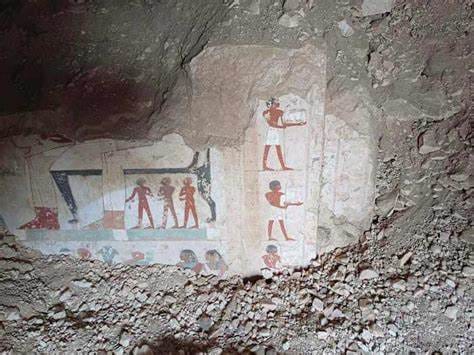Egyptian archaeologists have uncovered three ancient tombs in the historic necropolis of Dra Abu al-Naga, Luxor, shedding new light on burial customs and administrative life during the New Kingdom period.
Announced Monday by Egypt’s Ministry of Tourism and Antiquities, the discovery includes tombs that span from the Ramesside period to the 18th Dynasty, with inscriptions revealing the identities and roles of those buried—ranging from estate officials to temple supervisors.
The excavation was led by local experts under the Supreme Council of Antiquities, whose secretary-general, Mohamed Ismail Khaled, noted that further analysis of the inscriptions is underway. “These findings are only the beginning,” he said, suggesting more historical context could be unearthed as research continues.
The ministry has published images of the artifacts found within the tombs, including statues and funerary items—offering glimpses into the personal and religious lives of ancient Egyptians. The announcement comes as Egypt prepares for the long-awaited full opening of the Grand Egyptian Museum in Giza, which will house over 100,000 artifacts from across Egypt’s ancient history.
Among the tombs is that of Amum-em-Ipet, a Ramesside official who served in the estate of the god Amun. While much of his tomb has suffered damage, surviving artwork includes scenes of funeral processions and ceremonial banquets. The structure features a courtyard, a square hall, and a niche—partially destroyed—along the western wall.
Another tomb belongs to Baki, identified as a grain silo supervisor during the 18th Dynasty. His resting place includes a corridor-style courtyard, a transverse hall, and a chamber containing a burial shaft. A third tomb, belonging to an official referred to as “S,” reveals a more complex identity—he is described as a temple supervisor, scribe, and mayor of the northern oases. His tomb layout includes a well, entranceway, and incomplete inner hall.
Tourism and Antiquities Minister Sherif Fathi welcomed the discovery as a valuable addition to Egypt’s cultural heritage and a boost for the country’s growing archaeological tourism. “This is more than a scientific achievement; it’s an opportunity to draw the world’s attention to the wealth of African civilization,” he said.
Luxor continues to be a focal point for archaeological exploration. In January, researchers uncovered ancient tombs and burial shafts dating back over 3,600 years near Queen Hatshepsut’s funerary temple. Just months earlier, a joint Egyptian-American team unearthed 11 sealed burials from the Middle Kingdom at the nearby South Asasif necropolis.
These latest discoveries reinforce Egypt’s central role in African and global heritage, offering yet another reason for the continent to celebrate and preserve its deep-rooted history.



